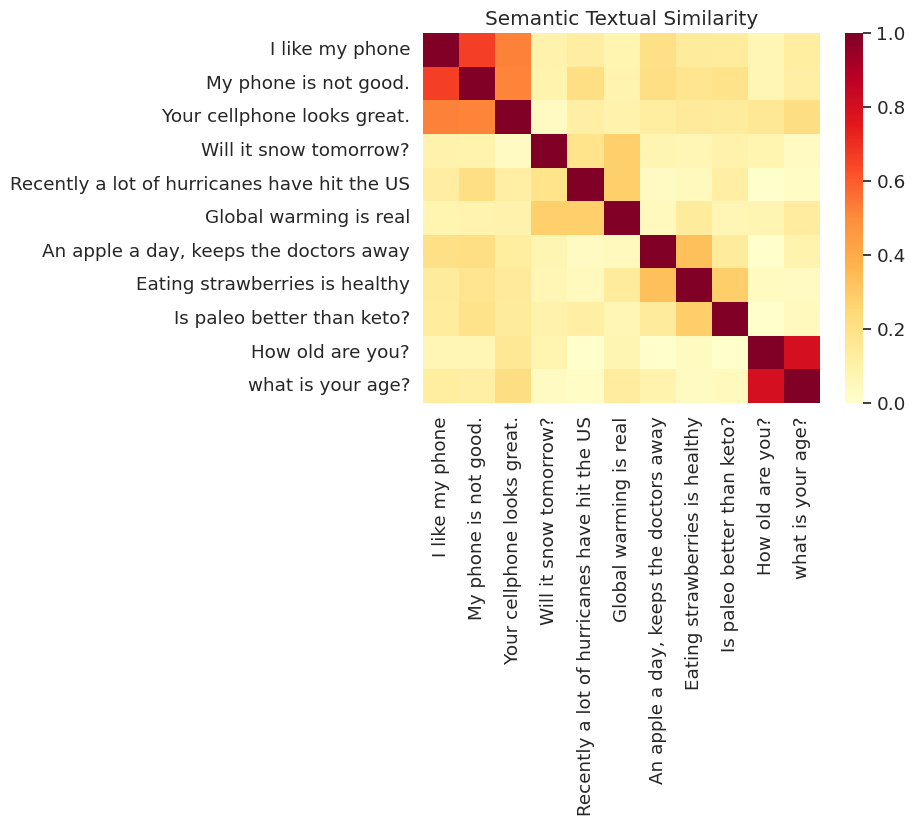 TensorFlow.org'da görüntüleyin TensorFlow.org'da görüntüleyin |  Google Colab'da çalıştırın Google Colab'da çalıştırın |  GitHub'da görüntüle GitHub'da görüntüle |  Not defterini indir Not defterini indir |  TF Hub modellerine bakın TF Hub modellerine bakın |
Bu not defteri, Evrensel Cümle Kodlayıcıya nasıl erişileceğini ve cümle benzerliği ve cümle sınıflandırma görevleri için nasıl kullanılacağını gösterir.
Evrensel Cümle Kodlayıcı, cümle düzeyinde gömmeler almayı, tek tek kelimeler için gömmelere bakmak için geçmişte olduğu kadar kolay hale getirir. Cümle yerleştirmeleri, daha sonra, daha az denetimli eğitim verisi kullanarak aşağı akış sınıflandırma görevlerinde daha iyi performans sağlamak için cümle düzeyinde anlam benzerliğini hesaplamak için önemsiz bir şekilde kullanılabilir.
Kurmak
Bu bölüm, TF Hub'da Evrensel Cümle Kodlayıcıya erişim ortamını kurar ve kodlayıcının sözcüklere, cümlelere ve paragraflara uygulanmasına ilişkin örnekler sağlar.
%%capture
!pip3 install seaborn
Yüklemeden Tensorflow hakkında daha detaylı bilgi bulunabilir https://www.tensorflow.org/install/ .
Evrensel Cümle Kodlayıcının TF Hub modülünü yükleyin
from absl import logging
import tensorflow as tf
import tensorflow_hub as hub
import matplotlib.pyplot as plt
import numpy as np
import os
import pandas as pd
import re
import seaborn as sns
module_url = "https://tfhub.dev/google/universal-sentence-encoder/4"
model = hub.load(module_url)
print ("module %s loaded" % module_url)
def embed(input):
return model(input)
module https://tfhub.dev/google/universal-sentence-encoder/4 loaded
Desteklenen çeşitli uzunlukları gösteren her mesaj için bir temsil hesaplayın.
word = "Elephant"
sentence = "I am a sentence for which I would like to get its embedding."
paragraph = (
"Universal Sentence Encoder embeddings also support short paragraphs. "
"There is no hard limit on how long the paragraph is. Roughly, the longer "
"the more 'diluted' the embedding will be.")
messages = [word, sentence, paragraph]
# Reduce logging output.
logging.set_verbosity(logging.ERROR)
message_embeddings = embed(messages)
for i, message_embedding in enumerate(np.array(message_embeddings).tolist()):
print("Message: {}".format(messages[i]))
print("Embedding size: {}".format(len(message_embedding)))
message_embedding_snippet = ", ".join(
(str(x) for x in message_embedding[:3]))
print("Embedding: [{}, ...]\n".format(message_embedding_snippet))
Message: Elephant Embedding size: 512 Embedding: [0.008344474248588085, 0.00048079612315632403, 0.06595245748758316, ...] Message: I am a sentence for which I would like to get its embedding. Embedding size: 512 Embedding: [0.05080860108137131, -0.016524313017725945, 0.015737781301140785, ...] Message: Universal Sentence Encoder embeddings also support short paragraphs. There is no hard limit on how long the paragraph is. Roughly, the longer the more 'diluted' the embedding will be. Embedding size: 512 Embedding: [-0.028332678601145744, -0.05586216226220131, -0.012941479682922363, ...]
Anlamsal Metinsel Benzerlik Görev Örneği
Evrensel Cümle Kodlayıcı tarafından üretilen yerleştirmeler yaklaşık olarak normalleştirilir. İki cümlenin anlamsal benzerliği, kodlamaların iç çarpımı olarak önemsiz bir şekilde hesaplanabilir.
def plot_similarity(labels, features, rotation):
corr = np.inner(features, features)
sns.set(font_scale=1.2)
g = sns.heatmap(
corr,
xticklabels=labels,
yticklabels=labels,
vmin=0,
vmax=1,
cmap="YlOrRd")
g.set_xticklabels(labels, rotation=rotation)
g.set_title("Semantic Textual Similarity")
def run_and_plot(messages_):
message_embeddings_ = embed(messages_)
plot_similarity(messages_, message_embeddings_, 90)
Benzerlik Görselleştirildi
Burada benzerliği bir ısı haritasında gösteriyoruz. Nihai grafik her giriş, bir 9x9 matristir [i, j] cümle için kodlama iç ürüne göre renkli i ve j .
messages = [
# Smartphones
"I like my phone",
"My phone is not good.",
"Your cellphone looks great.",
# Weather
"Will it snow tomorrow?",
"Recently a lot of hurricanes have hit the US",
"Global warming is real",
# Food and health
"An apple a day, keeps the doctors away",
"Eating strawberries is healthy",
"Is paleo better than keto?",
# Asking about age
"How old are you?",
"what is your age?",
]
run_and_plot(messages)

Değerlendirme: STS (Semantik Metinsel Benzerlik) Benchmark
STS Deney benzerlik skorları insan yargılarla cümle kalıplamaların hizalama kullanılarak hesaplanmaktadır ettiği bir derece içsel bir değerlendirme sağlar. Karşılaştırma, sistemlerin çeşitli cümle çiftleri seçimi için benzerlik puanları döndürmesini gerektirir. Pearson korelasyon daha sonra insan yargılar karşı makine benzerlik puanları kalitesini değerlendirmek için kullanılır.
Verileri indir
import pandas
import scipy
import math
import csv
sts_dataset = tf.keras.utils.get_file(
fname="Stsbenchmark.tar.gz",
origin="http://ixa2.si.ehu.es/stswiki/images/4/48/Stsbenchmark.tar.gz",
extract=True)
sts_dev = pandas.read_table(
os.path.join(os.path.dirname(sts_dataset), "stsbenchmark", "sts-dev.csv"),
error_bad_lines=False,
skip_blank_lines=True,
usecols=[4, 5, 6],
names=["sim", "sent_1", "sent_2"])
sts_test = pandas.read_table(
os.path.join(
os.path.dirname(sts_dataset), "stsbenchmark", "sts-test.csv"),
error_bad_lines=False,
quoting=csv.QUOTE_NONE,
skip_blank_lines=True,
usecols=[4, 5, 6],
names=["sim", "sent_1", "sent_2"])
# cleanup some NaN values in sts_dev
sts_dev = sts_dev[[isinstance(s, str) for s in sts_dev['sent_2']]]
/tmpfs/src/tf_docs_env/lib/python3.7/site-packages/IPython/core/interactiveshell.py:3444: FutureWarning: The error_bad_lines argument has been deprecated and will be removed in a future version. exec(code_obj, self.user_global_ns, self.user_ns)
Cümle Gömmelerini Değerlendirin
sts_data = sts_dev
def run_sts_benchmark(batch):
sts_encode1 = tf.nn.l2_normalize(embed(tf.constant(batch['sent_1'].tolist())), axis=1)
sts_encode2 = tf.nn.l2_normalize(embed(tf.constant(batch['sent_2'].tolist())), axis=1)
cosine_similarities = tf.reduce_sum(tf.multiply(sts_encode1, sts_encode2), axis=1)
clip_cosine_similarities = tf.clip_by_value(cosine_similarities, -1.0, 1.0)
scores = 1.0 - tf.acos(clip_cosine_similarities) / math.pi
"""Returns the similarity scores"""
return scores
dev_scores = sts_data['sim'].tolist()
scores = []
for batch in np.array_split(sts_data, 10):
scores.extend(run_sts_benchmark(batch))
pearson_correlation = scipy.stats.pearsonr(scores, dev_scores)
print('Pearson correlation coefficient = {0}\np-value = {1}'.format(
pearson_correlation[0], pearson_correlation[1]))
Pearson correlation coefficient = 0.8036394630692778 p-value = 0.0
